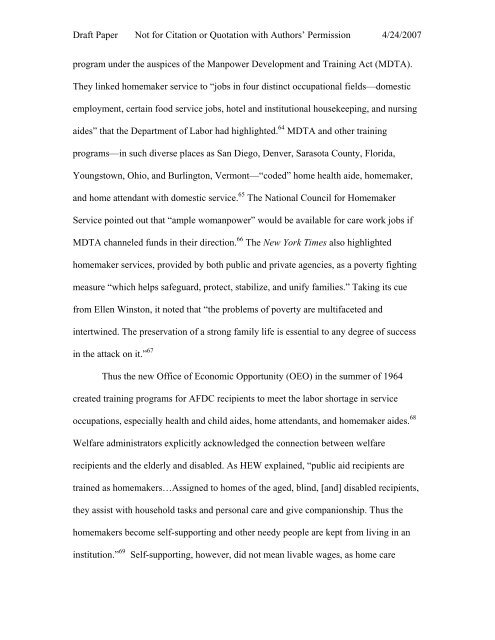Organizing Home Care: - School of Social Service Administration
Organizing Home Care: - School of Social Service Administration
Organizing Home Care: - School of Social Service Administration
You also want an ePaper? Increase the reach of your titles
YUMPU automatically turns print PDFs into web optimized ePapers that Google loves.
Draft Paper Not for Citation or Quotation with Authors’ Permission 4/24/2007<br />
program under the auspices <strong>of</strong> the Manpower Development and Training Act (MDTA).<br />
They linked homemaker service to “jobs in four distinct occupational fields—domestic<br />
employment, certain food service jobs, hotel and institutional housekeeping, and nursing<br />
aides” that the Department <strong>of</strong> Labor had highlighted. 64 MDTA and other training<br />
programs—in such diverse places as San Diego, Denver, Sarasota County, Florida,<br />
Youngstown, Ohio, and Burlington, Vermont—“coded” home health aide, homemaker,<br />
and home attendant with domestic service. 65 The National Council for <strong>Home</strong>maker<br />
<strong>Service</strong> pointed out that “ample womanpower” would be available for care work jobs if<br />
MDTA channeled funds in their direction. 66 The New York Times also highlighted<br />
homemaker services, provided by both public and private agencies, as a poverty fighting<br />
measure “which helps safeguard, protect, stabilize, and unify families.” Taking its cue<br />
from Ellen Winston, it noted that “the problems <strong>of</strong> poverty are multifaceted and<br />
intertwined. The preservation <strong>of</strong> a strong family life is essential to any degree <strong>of</strong> success<br />
in the attack on it.” 67<br />
Thus the new Office <strong>of</strong> Economic Opportunity (OEO) in the summer <strong>of</strong> 1964<br />
created training programs for AFDC recipients to meet the labor shortage in service<br />
occupations, especially health and child aides, home attendants, and homemaker aides. 68<br />
Welfare administrators explicitly acknowledged the connection between welfare<br />
recipients and the elderly and disabled. As HEW explained, “public aid recipients are<br />
trained as homemakers…Assigned to homes <strong>of</strong> the aged, blind, [and] disabled recipients,<br />
they assist with household tasks and personal care and give companionship. Thus the<br />
homemakers become self-supporting and other needy people are kept from living in an<br />
institution.” 69<br />
Self-supporting, however, did not mean livable wages, as home care
















